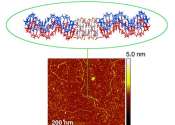Metal model mimics metalloenzymes
(Phys.org) —Metal ions play critical roles throughout biochemistry, often facilitating the cleavage of the bond between the two atoms in an oxygen molecule in metalloenzymes. They are the key to oxidizing organic molecules ...







